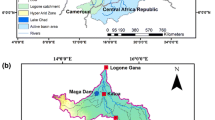Abstract
A multi-objective regional calibration technique that incorporates a sequential regionalisation procedure was introduced and evaluated based on 12 catchments in Korea. This study was focused on investigating the impacts of the predictive capacity of a rainfall-runoff model for multiple objectives on the adequacy of regional relationships during the regional calibration. The effectiveness of the regional calibration using a multi-objective approach was evaluated by comparing the predictive performance of the regional calibration using a single-objective approach. The comparative assessment of the regional calibration approaches in the regionalisation suggests that the predictability of the regional models derived from the multi-objective regional calibration approach is generally good and reasonable with respect to the simultaneous catchment response to high and low flows and water balance. However, the multi-objective regional calibration approach displayed weaknesses associated with matching the water balance in the hydrograph, which was primarily caused by the reduced variation of the regional parameters. A more extensive study with a larger number of catchments is needed to develop more accurate regional relationships from the multi-objective regional calibration approach.








Similar content being viewed by others
References
Beven K, Freer J (2001) Equifinality, data assimilation, and uncertainty estimation in mechanistic modelling of complex environmental systems using the GLUE methodology. J Hydrol 249(1–4):11–29
Blöschl G, Sivapalan M (1995) Scale issues in hydrological modelling: a review. Hydrol Process 9(3–4):251–290. doi:10.1002/hyp.3360090305
Deckers DEH, Booij M, Rientjes TM, Krol M (2010) Catchment variability and parameter estimation in multi-objective regionalisation of a rainfall-runoff model. Water Resour Manag 24(14):3961–3985. doi:10.1007/s11269-010-9642-8
Fernandez W, Vogel RM, Sankarasubramanian A (2000) Regional calibration of a watershed model. Hydrol Sci J 45(5):689–707
Gupta HV, Sorooshian S, Yapo PO (1998) Toward improved calibration of hydrologic models: multiple and noncommensurable measures of information. Water Resour Res 34. doi:10.1029/97wr03495
Hundecha Y, Bardossy A (2004) Modeling of the effect of land use changes on the runoff generation of a river basin through parameter regionalization of a watershed model. J Hydrol 292(1–4):281–295
Hundecha Y, Ouarda TBMJ, Bardossy A (2008) Regional estimation of parameters of a rainfall-runoff model at ungauged watersheds using the spatial structures of the parameters within a canonical physiographic-climatic space. Water Resour Res 44(1), W01427. doi:10.1029/2006wr005439
Jakeman AJ, Hornberger GM (1993) How much complexity is warranted in a rainfall-runoff model? Water Resour Res 29(8):2637–2649
Kim HS, Lee S (2013) Assessment of the adequacy of the regional relationships between catchment attributes and catchment response dynamics, calibrated by a multi-objective approach. Hydrol Process. doi:10.1002/hyp.9942
Kim HS, Croke BFW, Jakeman AJ, Chiew FHS (2011) An assessment of modelling capacity to identify the impacts of climate variability on catchment hydrology. Math Comput Simul 81(7):1419–1429
Lamb R, Crewett J, Calver A (2000) Relating hydrological model parameters and catchment properties to estimate flood frequencies from simulated river flows. Paper presented at the BHS 7th National Hydrology Symposium, Newcastle-upon-Tyne, UK
Merz R, Blöschl G (2004) Regionalisation of catchment model parameters. J Hydrol 287(1–4):95–123
Parajka J, Blöschl G, Merz R (2007) Regional calibration of catchment models: potential for ungauged catchments. Water Resour Res 43(6), W06406. doi:10.1029/2006wr005271
Seibert J (1999) Regionalisation of parameters for a conceptual rainfall-runoff model. Agricultural and Forest Meteorology 98–99:279–293
Wagener T, Wheater HS (2006) Parameter estimation and regionalization for continuous rainfall-runoff models including uncertainty. J Hydrol 320(1–2):132–154
Author information
Authors and Affiliations
Corresponding author
Rights and permissions
About this article
Cite this article
Kim, H.S. Adequacy of a Multi-objective Regional Calibration Method Incorporating a Sequential Regionalisation. Water Resour Manage 28, 5507–5526 (2014). https://doi.org/10.1007/s11269-014-0819-4
Received:
Accepted:
Published:
Issue Date:
DOI: https://doi.org/10.1007/s11269-014-0819-4




